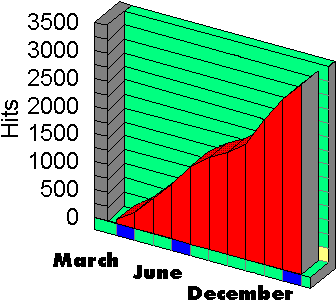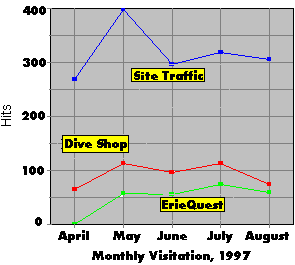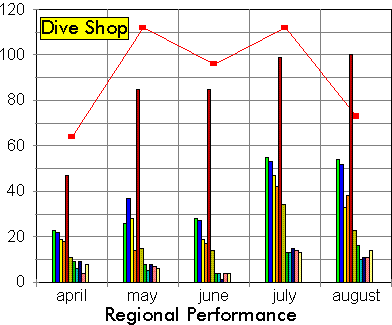A Service of Colautti Enterprises
Dive Into the Net was completed and active June 1, 1996. During that time it was field tested it was not listed with any search engines. The preliminary work was completed and the site released to the search engines March 1, 1997. Using the information provided by our ISP, Interlog Services the transfer stats were compiled and used to build a database from which to track the sites performance.
Typically most web sites take several months to be discovered and then the visitation to the site either grows if the site is valuable, or drops off if the site is poorly done. Dive into the Net has performed extremely well in the first ten months since it went online.
What follows here is a detailed analysis of the sites performance that demonstrates the effectiveness of the approach Dive Into the Net takes to promote the businesses that advertise here.

The site experienced a surprising amount of traffic after the initial few months delay as the search engines logged the site and people gradually became aware of it. The appearance of the web site in favourable reviews in Diver Magazine as well as numerous other web sites helped spur the initial growth. During the same time period we tracked a selection of web pages on scuba diving in Ontario. The average visitation rate per year was approximately two thousand. Dive Into the Net is well on the way to double the average hits for a scuba site in Ontario.
This number may seem low if you have bought into the hype that web sites routinely have hits in the millions. It certainly can happen, but only to very specific sites that have a broad appeal. In niche markets like Scuba Diving or Rocketry or Lacrosse, you have a much smaller audience. It is unfortunate that the Internet has been misrepresented in commercials that mislead the viewer into believing that millions of visitors from around the world pour into every web site. Web sites hit a target market. Site traffic of two thousand to four thousand scuba divers per year represents excellent results in Ontario.

The most important question as a potential advertiser you would want answered is to know how much of the site traffic actually reaches the advertisements? Unlike the typical click through ads used on the Internet, Dive Into the Net integrates the advertisement into the pages. The result have been excellent so far. On average a minimum of 30% of the site traffic made it to the advertisements during the first six months. This is a much higher follow through than on a typical click-through web site. The click-through model has been justifiably criticised. A recent Toronto Star article mentions that only 2% of visitors to web pages actually follow the click-through ad.
The time frame of the chart shows the businesses from their debut on the site in 1997, until the seasons end. The analysis to the end of the year is not available at this time. What you can see is that this web site is a viable method of attracting visitors to commercial web sites. Before the season ended the web presence generated business for both groups mentioned.
Keep in mind that not only is this platform producing numerical results for the businesses involved, but that it is providing a wealth of information so that curious and informed customers are now at your advertisment. Without the background information that Dive Into the Net is providing your individual web page might be rendered meaningless and unusable to a very large portion of the diving audience.
The importance of this crucial difference in Dive Into The Net from any other advertising platform is the defense in depth. Web hits can be thought of in two categories: Hit-and-runs and real hits. Hit and runs are the curious who hit the site and back right out of it because it is irrelevant, poorly done, or too time consuming to download. These visitors may trip the hit counter, but are actually not customers.
Real hits are visitors who came for a reason. They are potential clients and are very interested in your offerings. Hit counters cannot separate real hits from the false hit-and-runs. However, Dive Into the Net has set up a database, and the ads are at the bottom of the database. Hit and run surfers do not penetrate to that level in a site for no reason. The transfer stats have shown that this site is visited in depth. Visitors are thorougly exploring the site contents and pursuing the information to the logical conclusion, the advertisements that can help them go diving. In field tests, the average time for a person to thorougly explore the site was over an hour. The site has demonstrated its ability to catch and hold customers and produce results for advertisers.

The site traffic can be looked at regionally as well. The bars show the traffic from regions 1-12. Regions 2 and 4 are combined into the second bar. The line shows the performance of one advertiser during this time period. The site traffic is distributed across all sites, with the highest site traffic at the most information dense regions- 1 and 6. The regional traffic grows throughout the summer. The traffic to the advertiser exceeds the traffic to any single regional page. This is because there are several more pathways to the Dive Shop ad than just the regional maps. Visitors may come into the site through the lake based maps, advertisers index, sub-regional maps or as external visitors to the site.
The advertiser had excellent performance in the first few months online, typically a very slow time for many pages. The traffic has grown considerably since this compilation.
Again, it must be remembered that not only was the advertisers web page well visited but that the potential customer received a wealth of information about the environment the particular dive shop was located in as they navigated through the site. Thus, what might just be a meaningless ad on the internet is now a real place, and the diver has a real reason to wish to visit the area concerned.
It is also not surprising that the results showed that visitors concentrated on the pages with the most information on the diving environment, and not on the area with the most advertisements. Visitors want information not hype. The diving database the site provides is the real pull factor to the site, not the shop web page. It is the essential ingredient that makes this site effective.
SITE INDEX: [MAIN MENU] [MAP INDEX] [QUICK INDEX] [American Visitors] [World Wide Visitors] [Canadian Visitors] [Help]
© M. Colautti 1996-1999, 2000</>
Visit the new national site CanExplore